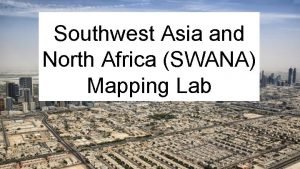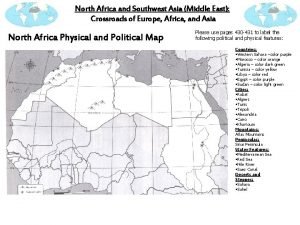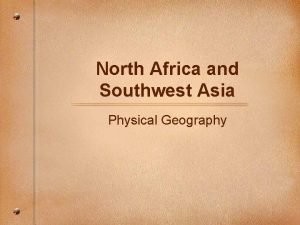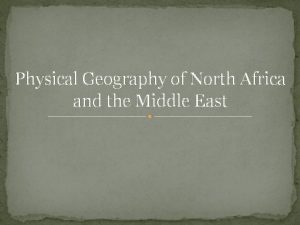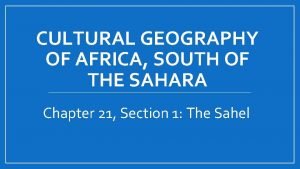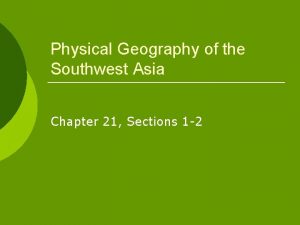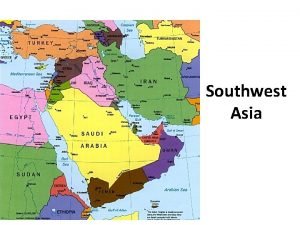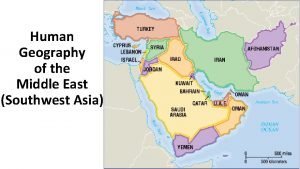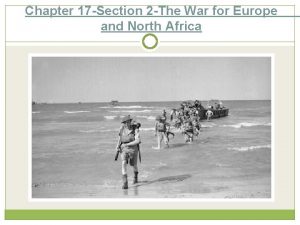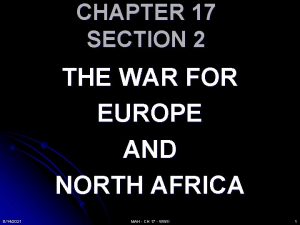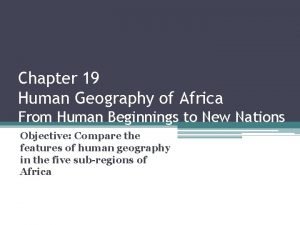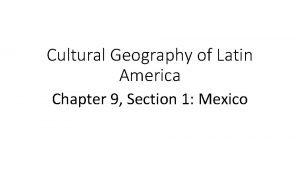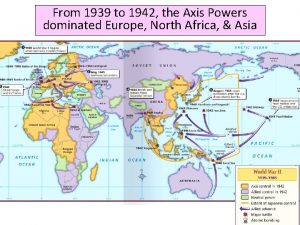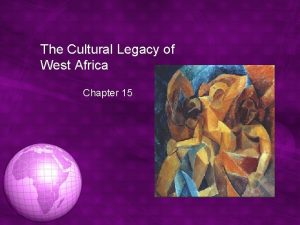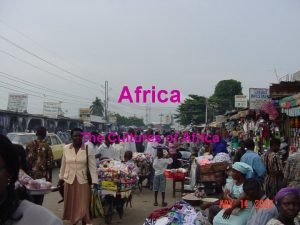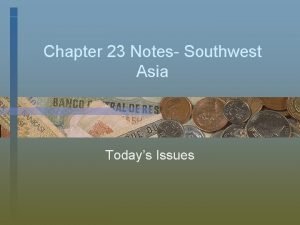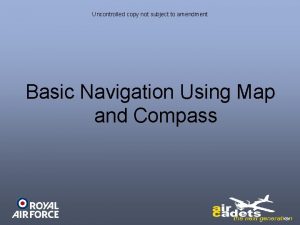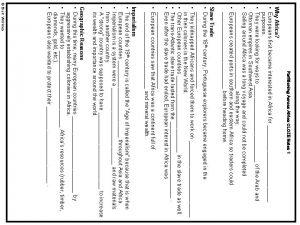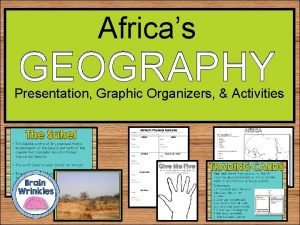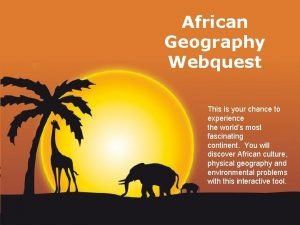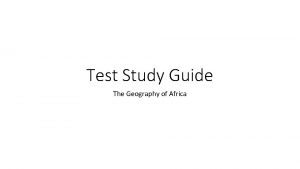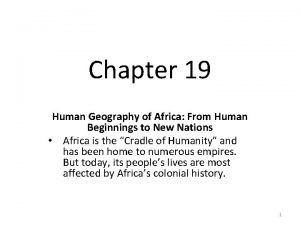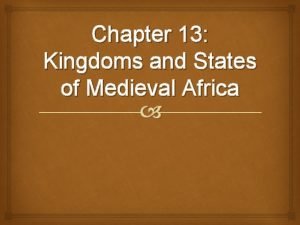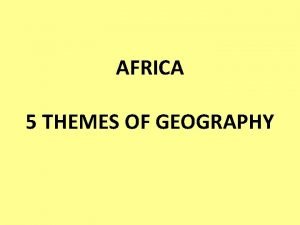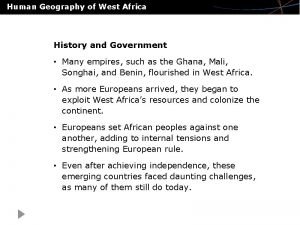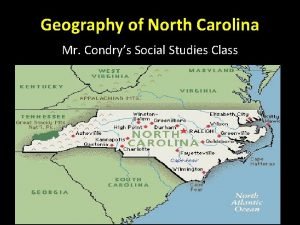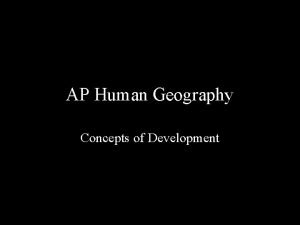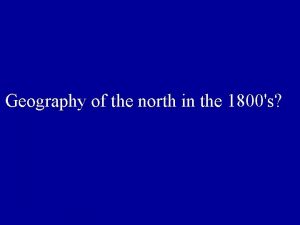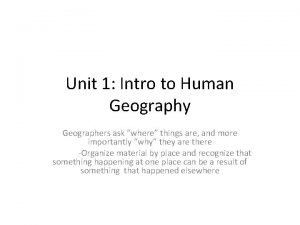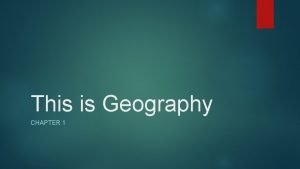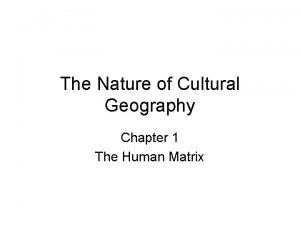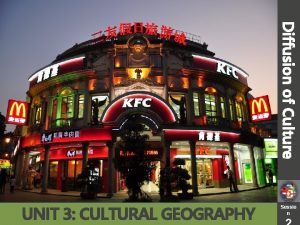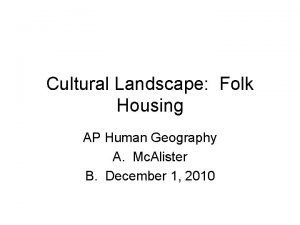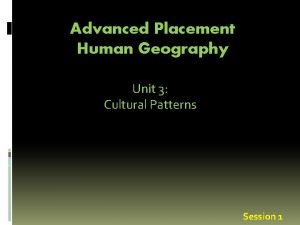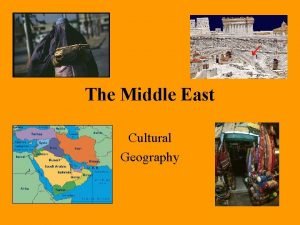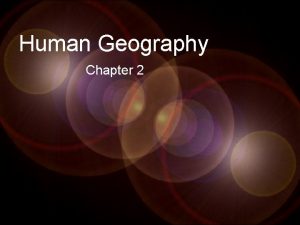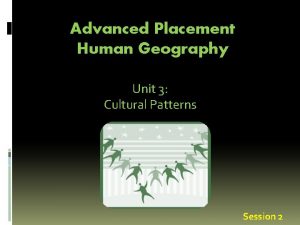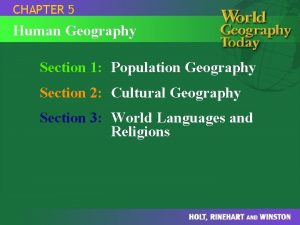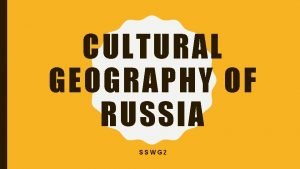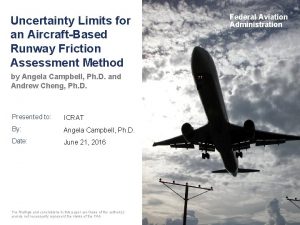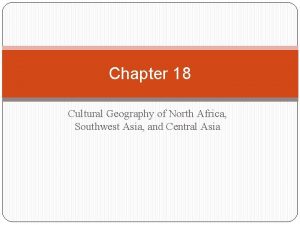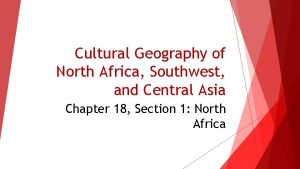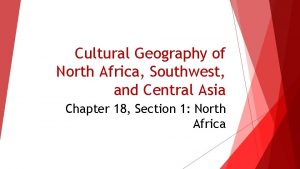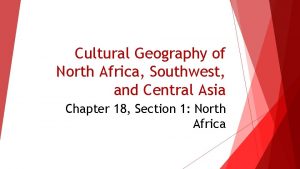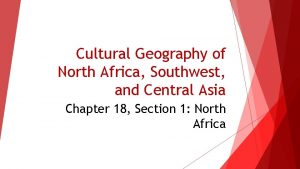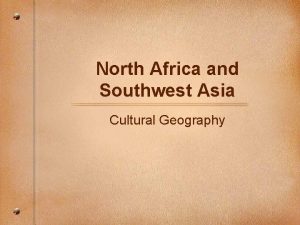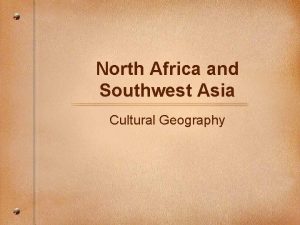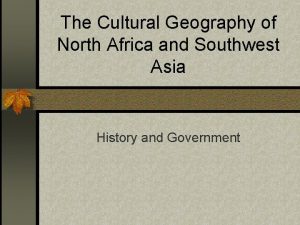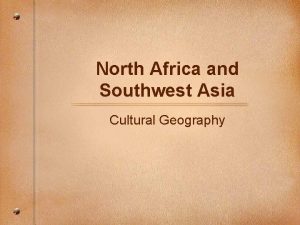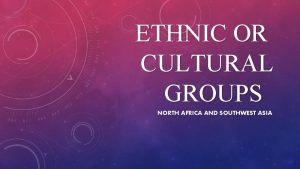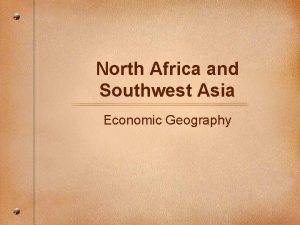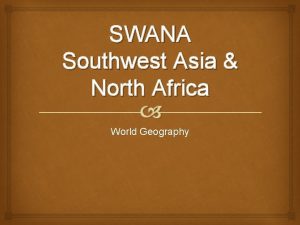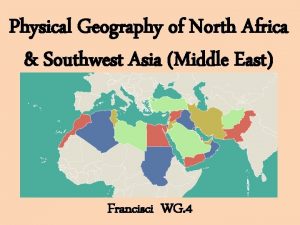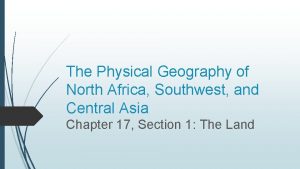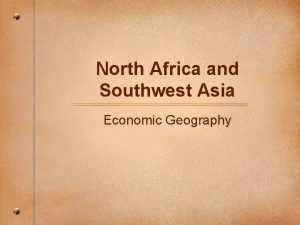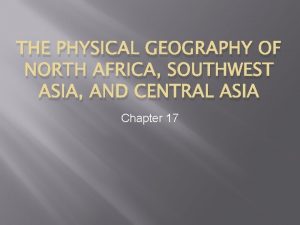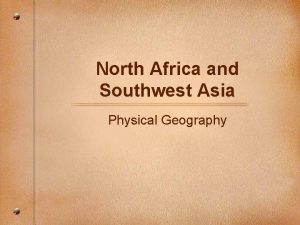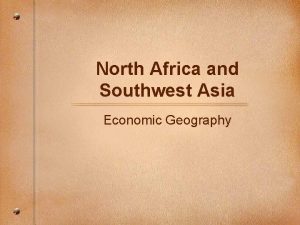Chapter 18 Cultural Geography of North Africa Southwest






























































- Slides: 62

Chapter 18 Cultural Geography of North Africa, Southwest Asia, and Central Asia

1. North Africa Birthplace of earliest civilizations Rich cultural heritage Traditions and cultures have changed with modernization and urbanization

Population Patterns Indigenous ethnic groups, migrations, and the dramatic climate have shaped population patterns in North Africa Indigenous cultures in North Africa have mixed with those from Arabian Peninsula and Europe

The People Primary influence on the sub region is a mix of indigenous and Arab cultures Indigenous people of North Africa called Berbers Most are farmers today Previously they were pastoral nomads, groups of people who move from place to place grazing their animals Berbers are most populous in the Atlas Mountains and in the Sahara

The People Other principal ethnic group in North Africa - Arabs Egyptian civilization, 6000 years ago Spread throughout North Africa in the 600’s Bedouin - nomadic, Arabic-speaking people, migrated from deserts of Southwest Asia, herd animals in deserts

The People North African peoples have had continuous contact with Europe for hundreds of years French, Spanish Muslims and Romans have all influenced the culture in this sub region

Density and Distribution Geographic factors, such as availability of water, influenced settlement in North Africa People settled along seacoasts and in river deltas, or mouths, such as along Nile River in Egypt Nile Delta region one of world's most densely populated areas Major population centers in North Africa are urban Examples: Casablanca, Morocco Algiers, Algeria Tunis, Tunisia Tripoli, Libya Cairo, Egypt Cities in the region have grown rapidly some have not had the infrastructure, basic urban necessities such as streets and utilities, to support this growth

Early Peoples and Civilizations Hunters and gatherers settled in North Africa about 10, 000 years ago By 6000 BC, farming communities rise up along Nile River and Mediterranean Sea Region’s farmers among the first to domesticate plants and animals Egyptian civilization developed along the Nile River about 6000 years ago Egyptians: 1. Created a calendar year with 365 days 2. Used sophisticated irrigation systems 3. Built pyramids as tombs to for their rules 4. Invented form of picture writing called hieroglyphics

Invasions of North Africa Seventh century invasions of Arabs from Arabian Peninsula Arabs have heavily influenced cultures of North Africa since Arabs brought Islamic religion and culture to Morocco Spanish Muslim and Jewish exiles fleeing Christian persecution settled in Morocco in 1400 s Ottoman Empire conquered Algeria in 1500 s France conquered Algeria in mid 1800 s Geometric boundaries, or straight line boundaries which do not account for natural and cultural features, exist between Libya, Egypt and Algeria These boundaries were drawn by European colonial powers, often caused conflict

Independence During 1800’s, well-educated urban middle class adopts nationalism, or a belief in the right of an ethnic group to have its own independent country Egypt gained independence from UK in 1922 Suez Canal, important shipping lane that connect the Mediterranean Sea to the Red Sea across Egypt, has made Egypt a key power Algeria gained independence from France in mid 1900 s Libya won independence from Italy in 1951 Then ruled by strong, Western-friendly monarchy In 1969, coup led by Colonel Muammar al-Qaddafi overthrew the monarchy Qaddafi has ruled the oil rich country to this day

Religion and Language Arabs brought religion of Islam to North Africa when they invaded Most were Sunni, which makes up 85% of 1. 5 billion Muslims world wide Sunnis believe that leadership should be in the hands of the Islamic community at large Most Berbers have adopted Islam Calls to worship occur five times each day in countries with large Muslim populations Muezzin, or crier, calls the faithful to prayer from a tower of each local mosque Following the movements of the imam, or prayer leader, they bow and kneel, touching foreheads to the ground in the direction of the holy city of Makkah (Mecca) in Saudi Arabia Arabic language also spread across North Africa Non-Arab Muslims learned Arabic in order to read the Quran, the Islamic holy book Arabic became the regions main language

Education and Health Care Most young people in North Africa attend school Primary education is free Literacy rates range widely, from 52 percent in Morocco to 82 percent in Libya Health care has also improved recently People often go to government-owned hospitals for medical treatment, but doctor shortages mean limited care for rural people

The Arts Egyptians built towering pyramids to serve as royal tombs for their leaders Arts of weaving, embroidery and metalworking in the region are highly influenced by Islam

2. The Eastern Mediterranean birthplace of three major world religions; Judaism, Christianity and Islam Different peoples have laid claim to the lands for religious reasons Periods of conflict and war have resulted In Israel today, Jewish and Palestinian people both claim rights to the same lands

Population Patterns Migrations, claims to ancestral homes, boundary disputes have influenced pop. patterns in the eastern Mediterranean Inhabited by millions of Arab and Jewish people speak Hebrew, and if they are religious, practice Judaism Arabs speak Arabic, and primarily practice Islam

The People 7. 1 million people living in E. Mediterranean are Israelis living in Israel 80% are Jewish Jews trace heritage to Israelites in ancient times settled in Canaan, land shared today by Israel and Lebanon Israelites believed that God had given them this area as a homeland Over time, many Jews moved to other countries

The People In 1948, Israel founded as a Jewish state Arabs in the region did not want Jewish state Tensions between Arabs and Jews have led to many wars Palestinians – Arabs displaced from their homes during wars with Israel, forced to live as refugees in neighboring countries such as Syria,

Density and Distribution Dry climate causes majority in Eastern Mediterranean to live along Euphrates River Some of the highest population densities in Southwest Asia Lebanon - population density of 941 people per square mile Region is primarily urban More than 75% of people in Israel, Jordan and Lebanon live in cities Over 50% in Syria and Palestine live in cities Israel has experienced intense immigration since founding in 1948 1 million Jews have migrated from former Soviet

History and Government Eastern Mediterranean home to three of the world's major religions Has shaped politics and culture here for centuries Due to proximity to Europe, Africa and Asia, Eastern Mediterranean has been occupied throughout history

Early Civilizations Region has been occupied by important cultures and empires Ebla, Syria was an important commercial trade center by 3000 BC populated by hundreds of thousands of people by around 2400 BC Damascus, Syria, one of the oldest cities in the world, continuously settled

Religion as History Three major religions began here: Judaism, Christianity, and Islam All share many beliefs, particularly monotheism, or belief in one god Jerusalem is of special importance to all three religions

Judaism One of the oldest of the monotheistic faiths Trace origin to the ancient Israelites, who created kingdom of Israel along the eastern Mediterranean coast Jerusalem was their capital and religious center Jews recorded their history in the Hebrew Bible, consisting of the Torah, the prophets and the sacred writings

Christianity In 30 AD, Jewish teacher named Jesus began preaching and gathering followers Followers believed they would go to heaven after death Became basis for Christianity Christian Scriptures included the Hebrew Bible (Old Testament), the New Testament (writings and teachings of Jesus and early Christian communities)

Islam States that AD 610, revelations from God came to Muhammad a merchant in the city of Mecca in the Arabian Peninsula (Saudi Arabia) Followers claimed he was last in line of prophets, or messengers, that included Abraham and Jesus By AD 700, Islam spread through the region and into Europe Muslims built mosques, or houses of worship

Independence and Conflict Over time, Islamic empires in region rose and fell Physical geography limited sub regions economic development Lacked resources such as minerals, wood and coal to fuel industrial revolution like Europe By late 1800 s, European powers controlled large areas in the eastern Mediterranean

Arab-Israeli Conflict Jews expelled from their homeland by the Romans Jews settled in communities all over the world, often experiencing persecution Many Jews, called Zionists, began to call for a return to Palestine After WWII, wars broke out among Jews, Arabs and British forces in the region UN decided in 1947 to divide Palestine into a Jewish state and an Arab state When British withdrew form the area, the Jews proclaimed the Independent state of Israel in 1948 Arabs and Israelis fought 6 wars in next 25 years In 1948 and 1967 conflicts, victorious Israeli forces

Religion and Language Majority who practice Islam follow Sunni branch Arabs in Syria and Lebanon follow the Shia branch Jews and Christians make up only a small percentage of the population Most Jews live in Israel Christians live in Lebanon and Syria During Ramadan, the Muslim holy month, Muslims fast during daylight hours Many Muslims dress modestly Some Muslim women wear a veil over their face and completely cover their hands and feet Primary language is Arabic

Education and Health Care Compulsory and free Literacy rates vary from 76 percent in Syria to 96 percent in Israel Hospitals are often government owned

3. The Northeast Primarily Turkey, Iraq and Iran Region where cultures are fundamentally tied to religions Islam is the most practiced of them all. Islam now the fastest growing religion in the world.

The People Ethnic populations in Northeast migrated from Central Asia and Arabian Peninsula Religion of Islam has become a dominant aspect of these cultures

Turks Present day Turkey (formerly Anatolia) has been occupied by many different peoples in past 8000 years Turks migrated to the peninsula around AD 1000 from Central Asia One group, known as Ottoman Turks, built the Ottoman Empire OT ruled much of the eastern Mediterranean for more than 600 years Spanned an area that covered northern Africa, western Asia and southeastern Europe Most Turks practice Islam, speak Turkish

Iranians Appr. 67 million people live in Iran (formerly Persia) Iran means “land of the Aryans”, or Indo-Europeans who came from Southern Russia Iranians speak Farsi, or Persian Approximately 90 percent practice Shia Islam

Arabs Majority of people living in Iraq are Arabs (migrated from Arabian peninsula) Most Arabs in Iraq are Shia Musliams Only about 35 percent are Sunni Iraqi’s mostly speak Arabic

Kurds Have lived for more than 2000 years in the mountainous border areas of Turkey, Iraq and Iran Most are Sunni Muslims Most speak Kurdish, language related to Farsi Kurds call their territory Kurdistan Kurds have not gained independence, despite several tries

Density and Distribution Most populous countries in Northeast are Turkey and Iran (around 70 million each) Large cities and towns are common Large cities: Istanbul, Turkey Baghdad, Iraq Tehran, Iran These cities dominate social and cultural life in their respective countries

Civilizations and Empires Many civilizations arose in Mesopotamia, the area between the Tigris and Euphrates rivers (present day Iraq) This area became one of the worlds first culture hearths, or centers where cultures developed and spread outward Mesopotamia part of a large agricultural region known as the Fertile Crescent Mesopotamia was home to the Sumerian civilization Sumerians mastered farming by using irrigation Made great progress in mathematics and engineering, and created a code of law Developed a writing system call cuneiform, using wedge shaped symbols written on clay tablets

Civilizations and Empires Phoenician civilization, began along eastern Mediterranean coast, around 3000 BC Developed a new alphabet in which letters stood for sounds, formed the basis for modern alphabets 500 BC, Persian Empire extended across the region Persians built ganats , or underground canals, meant to prevent water from evaporating in surface canals

Civilizations and Empires Ottoman Empire, 1000 – 1600, present day Turkey Spanned an area that covered northern Africa, western Asia and southeastern Europe

The Modern Era Europeans controlled much of Northeast by late 1800 s Britain controlled Iraq until 1932 Since Iraq has experienced turmoil Ottoman Empire ended during WWI Turkey established in 1923 In Iran, their secular (non – religious) government was overthrown during the Islamic Revolution of 1979 Clerics, or mullahs, came to power, continue to rule today

The Era of Oil discovered in Persian Gulf in early 1900 s In late 1950’s, Iran, Iraq, Kuwait, Saudi Arabia, and Venezuela formed OPEC (Organization of Petroleum Exporting Countries) In 1973, OPEC placed an embargo, or ban on trade, to the US after becoming angry at US support of Israel in Arab-Israeli War

Language and Religion Most people who live in this region speak Arabic This is not the case in Iran and Turkey, however In Turkey, Turkic peoples speak Turkish In Iran, Persians speak Persian or Farsi Shia Muslims are the most populous religious group in both Iraq and Iran In Turkey, majority of Muslims are Sunni, but Turkey is more secular

Education and Health Care Required through grade 6 in Iraq and grade 8 in Turkey Literacy rate 80 percent in Iran and 86 percent in Turkey Since the 1979 Islamic Revolution, education in Iran has become more religious in focus Hospitals are government owned and often suffer from doctor shortages

4. The Arabian Peninsula A mix of tradition and modernity, religion and growing commerce People of the peninsula have adapted to this climate, especially the nomadic peoples

Population Patterns Harsh desert climate of Arabian Desert has led most people to live along the coasts.

The People Most people in the subregion are Arabs Most Arabs are Muslims Descent from ancient groups such as Egyptians, Phoenicians, Saharan Berbers Today, many immigrants have come to the Arabian Peninsula from Pakistan, India, Bangladesh and Iran in search of good jobs

Density and Distribution Harsh desert, lush coastal climates dictate where the majority of people live on the AP In Bahrain, 89 percent of the population live in Manama and Al Muharraq, its two main cities Discovery of oil in the early 1900 s led to increased wealth, modernization and immigration in many Arab countries In the United Arab Emirates, immigrants make up a majority of the population (only 15 -20 % of pop. are citizens) Foreign workers make up greater than 50 percent of Qatar’s population and more than 60 percent in Kuwait

History and Government Conquering empires have imposed cultures on peoples of the Arabian Peninsula that remain influential to this day People of the region sought protection from Great Britain in fighting off rule by other outsiders, such as the Ottoman Empire

Early Cultures and Conquests Vibrant cultures have existed on the AP for 5000 years Large settlements have existed primarily along the coast Powerful family ruled Arabian Peninsula beginning around 1750 Arabs struggled against invasion by Ottoman Empire Threatened by the Ottoman Empire, Arabs signed treaties with GB for protection in the 1800 -early 1900 s Kuwait, Bahrain and Quatar signed treaties with GB as well Saudi Arabia was established in 1932

Independence Kuwait gains independence from GB - mid 1900 s United Arab Emirates - established in 1971 UAE formed from a group of tribal sheikhdoms, or territories ruled by an Islamic religious leader Kuwait and Qatar are ruled by emirs, or princes Saudi Arabia, Bahrain and Oman are monarchies Saudi Arabia follows sharia’ah, or Islamic law, based on the Quran Standards of living vary widely across AP Urban countries with oil wealth have relatively high standards of living Qatar’s oil and gas reserves have given its people one of the highest per capita incomes in the world

Culture Foreign workers are bringing their own cultures to the area Large cities are growing in need for more foreign workers to support growing industries

Religion Sunni and Shia Muslims dominant on the peninsula Many believe in making a pilgrimage, or haji, to Mecca at least once in their life Ibadhism, found in Oman, differs form Shia and Sunni sects Ibadhists practice a moderate conservatism, choose ruler by communal consensus and consent Oman is the only Islamic country to have a majority Ibadhi population Wahhabi sect of Sunni branch, advocates the literal teachings of the Quran

Education and Health Care Most children and young people attend school Kuwait, 83 % literacy Qatar, 89% literacy Barain, 89% literacy Health care varies widely from country to country, and even more widely from urban to rural Government owned hospitals are not always fully staffed Private health care available, but often associated with a particular social or religious group

5. Central Asia A crossroads of cultures and empires A destination for people emigrating from their homelands to escape harsh political or economic situations

Population Patterns Challenges for Central Asia: Invasions Domination by numerous empires Rugged landscape

The People Afghanistan, located at southern tip of Central Asia Mountainous country Home to many ethnic groups due to migrations and invasions Pashtun is the predominant ethnic group

Density and Distribution Afghanistan – 30 million people, most populous country in Central Asia Population has been shaped by conflict 1915, 1 million Armenians in Turkey killed, deported or died of illness at hands of Ottoman Turks 20 percent of Armenia's people left looking for better life Georgia, 300, 000 have left or been displaced Majority of Tajikistan’s people live and work in river valleys

History and Government Location of C. A. has left people vulnerable to centuries of invasion After centuries of foreign domination, countries of C. A. working to find economic and political stability

Cultures and Conquest Cultural roots go back 2500 years Kingdom of Urartu dates back to 800 BC Ruled the entire Caucasus region Beginning in 100 BC, parts of CA prospered from the Silk Road, trade route connecting China with the Mediterranean Sea Many cities along this route thrived as trading centers

Cultures and Conquest In 1200 s AD, Genghis Khan and Mongol forces invade area and establish empire Negatives: killed many Positives: Brought paper money and safer trade routes Armenia resisted Today, Armenia is an enclave - territory that is culturally or ethnically different from surrounding larger cultures Over 90 percent of Armenians practice Christianity People of Azerbaijan, Islamic, surrounded by Christian Caucasus, form an exclave, or a distinct group of people who are isolated from the main or larger part of the country During 1900’s, Central Asia dominated by Soviet Union

Independence Numerous CA countries declared independence when Soviet Union dissolved in 1991 Soviet invasion of Afghanistan in 1979 prompted fighting by the mujahedeen, or freedom fighters After Soviets left, the fundamentalist Islamic Taliban took control of most of country Poverty and unemployment widespread across CA 2001, US overthrows Taliban in Afghanistan in retaliation for 9/11 New Afghan government still faces many challenges, corruption, resurgent Taliban

Language and Religion Majority speak Turkic languages Russia remains official language in Kazakhstan Islam dominant religion, with most practicing Sunni branch Christianity majority in two countries, Armenia and Georgia

Education and Health Care Public education, mandatory through secondary school in a few countries Tajikistan – 88 % literacy Armenia and Georgia – 99% literacy Health care weakened by breakup of Soviet Union
 North africa and southwest asia physical geography
North africa and southwest asia physical geography Physical map of swana
Physical map of swana Southwest asia and north africa map
Southwest asia and north africa map Is israel in africa or asia
Is israel in africa or asia Southwest asia and north africa physical map
Southwest asia and north africa physical map North africa and southwest asia mountains
North africa and southwest asia mountains Lesson 1 physical geography of southeast asia
Lesson 1 physical geography of southeast asia Physical features of the middle east map
Physical features of the middle east map Africa south of the sahara map
Africa south of the sahara map Chapter 22 human geography of southwest asia
Chapter 22 human geography of southwest asia Chapter 21 physical geography of southwest asia
Chapter 21 physical geography of southwest asia Peninsulas and waterways in southwest asia
Peninsulas and waterways in southwest asia Is middle east in asia
Is middle east in asia The war for europe and north africa chapter 17 section 2
The war for europe and north africa chapter 17 section 2 Chapter 17 section 2 the war for europe and north africa
Chapter 17 section 2 the war for europe and north africa Chapter 19 human geography of africa
Chapter 19 human geography of africa The cultural geography of europe chapter 12 answer key
The cultural geography of europe chapter 12 answer key Vocabulary activity 15 the cultural geography of russia
Vocabulary activity 15 the cultural geography of russia Vocabulary activity 9 cultural geography of latin america
Vocabulary activity 9 cultural geography of latin america Goodguysww.
Goodguysww. America asia africa
America asia africa The cultural legacy of west africa answers
The cultural legacy of west africa answers East africa has great cultural diversity because of its -
East africa has great cultural diversity because of its - Chapter 23 today's issues southwest asia
Chapter 23 today's issues southwest asia True north vs magnetic north
True north vs magnetic north North east and north cumbria integrated care system
North east and north cumbria integrated care system Chapter 14 lesson 4 people of the south
Chapter 14 lesson 4 people of the south The north pole ____ a latitude of 90 degrees north
The north pole ____ a latitude of 90 degrees north African geography cloze notes
African geography cloze notes Temperate region
Temperate region Physical features of kenya
Physical features of kenya Africa geography webquest
Africa geography webquest Africa geography unit test study guide
Africa geography unit test study guide The mutapa empire thrived on the trade of diamonds
The mutapa empire thrived on the trade of diamonds 13 kingdoms
13 kingdoms 5 themes of geography africa
5 themes of geography africa Medieval africa geography
Medieval africa geography Human geography of west africa
Human geography of west africa Label the niger and senegal rivers
Label the niger and senegal rivers North carolina relative location
North carolina relative location What is the dependency theory ap human geography
What is the dependency theory ap human geography Labor force in the north 1800s
Labor force in the north 1800s Perceptual region definition
Perceptual region definition The geometric arrangement of objects in space
The geometric arrangement of objects in space Cultural geography definition
Cultural geography definition Acculturation geography definition
Acculturation geography definition Middle atlantic folk house
Middle atlantic folk house Vocabulary activity 24 cultural geography of south asia
Vocabulary activity 24 cultural geography of south asia Cultural diffusion geography definition
Cultural diffusion geography definition Environmental perception definition ap human geography
Environmental perception definition ap human geography Cultural geography of the middle east
Cultural geography of the middle east Cultural cohesion ap human geography
Cultural cohesion ap human geography Cultural homogenization ap human geography
Cultural homogenization ap human geography Cultural relativism ap human geography
Cultural relativism ap human geography Example of cultural geography
Example of cultural geography Cultural geography of russia
Cultural geography of russia Ap human geography frq examples
Ap human geography frq examples 5 themes of geography ap human geography
5 themes of geography ap human geography Stateless nation
Stateless nation Southwest airlines flight 1248
Southwest airlines flight 1248 The southwest states and capitals
The southwest states and capitals Southwest va ems council
Southwest va ems council Southwest association of rail shippers
Southwest association of rail shippers

